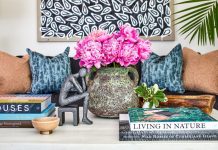When I walk into the Maryland Academy of Couture Arts in Timonium, Ella Pritsker, the fashion designer behind the Ella Moda label, greets me wearing crisp pinstripe trousers, a white collared blouse stitched with rainbow threading and a twill jacket lined with shiny gold buttons. In other words, she looks like a walking, talking Coco Chanel. When I compliment her outfit, she mentions that she makes most of her clothes. “I even made this,” Pritsker says, tugging at a red silk scarf knotted around her neck that could easily have been purchased at Saks.
As a young girl growing up in Soviet Russia, Pritsker began creating Barbie-like dresses for her paper dolls then quickly advanced to making full-fledged, tailored outfits as she grew older. At age 21, while waiting in Italy to come to the United States through the Hebrew Immigrant Aid Society, Pritsker befriended three
European dressmakers and found herself face to face with her deepest desires: hand-stitched custom couture and high-end fashion. “Working with them was when I knew this was what I would do with my life,” she says.
Arriving in Baltimore in 1990, Pritsker, barely knowing English, walked into A Fabric Place on Falls Road. Owner Michael Bearman offered her an armful of free samples and when she returned with seven hand-sewn Cinderella ball gowns, he began recommending her to his clientele. Seven years later, Ella Moda, a haute couture clothing line customized for executive women, was born. “My interest has always been a classic European style, and I always stay true to that,” says Pritsker.
Wanting both to preserve the fine art of traditional dressmaking and to educate others, Pritsker founded the Maryland Academy of Couture Arts and offered her first class, “Pattern Making and Design,” in spring 2009. The 14-week curriculum teaches the ways of the top fashion houses in Paris, using custom design methods instead of traditional American practices. Amazed, I wonder aloud if I, a notorious bobbin jammer who hadn’t picked up a needle since my seventh-grade home economics class, could create anything wearable, much less high-fashion, but Pritsker has no doubts. “You’ll make something that will fit you like a glove,” she assures me. “It will fit better than anything you’ve ever bought in a department store.”
I follow her into the classroom, where an intricate black floor-length gown made of sheer silk and a taffeta collar quickly catches my eye. This upscale version of the little black dress, I later learn, had earned raves at the 2004 Alliance for a New Humanity runway show in Puerto Rico. Close by, a chaise lounge and a tall mirror reach up to the vanilla-colored ceiling and rolls of cashmere are neatly stacked under the workstations. Taking in the “Project Runway” feel, I quickly forget I’m in a tidy corner studio nestled up on the fifth floor of an office building.
At the beginning of class, my four classmates and I stand at the white drafting desks designed specifically by Pritsker. Each houses an individual steamer, lamp, sewing tools, sewing machine— and not much else. Pritsker doesn’t believe that real designers need the newest gadgets. She’s a purist, and lives by the traditional way of creating couture.
Since I’m just sitting in for the night, I’m placed in the hands of Tori Burns, a nonprofit fundraiser by day and budding designer by night who aspires to make dressmaking a central part of her professional life. “I’ve always sewn from patterns but everything I sewed looked homemade. At a loss, I read a profile on Ella and knew exactly where I needed to be,” says Burns. “Now I call myself ‘the aspiring couturier.’”
Eager to show me the ropes, she gathers my introductory worksheets and begins by explaining that first she will help me measure myself, which, to my horror, means stripping down to my underwear and standing in the middle of the classroom in front of the mirrors.
 Measuring the couture way also involves locating focal points, which is done by marking taped Xs on the center of the front, side and back of the neck, as well as the shoulder bone, the chest bone and under the arm along the waist.
Measuring the couture way also involves locating focal points, which is done by marking taped Xs on the center of the front, side and back of the neck, as well as the shoulder bone, the chest bone and under the arm along the waist.
My attention quickly goes from shyness to mathematical confusion. My skills with fractions are rusty, to put it kindly, especially when trying to subtract thirds from sixteenths. Thank goodness Pritsker comes to my rescue. “I’ll show you a trick for working with fractions,” she says, bending the measuring tape and moving her finger in increments of thirds to come up with the answer. Within an hour, I’ve finished calculating all the required 38 measurements, including the width of my armhole crease, bust height and abdomen.
I didn’t understand why we were doing all this measuring until Burns lets me in on the basis of the entire course. Students would create their own sloper, or personalized pattern, from the measurements just taken. In most sewing classes a pattern is supplied, but Pritsker’s class bleeds couture every step of the way. “We start out with a square block,” says Burns, unrolling a piece of design paper. “And we will be using the measurements we took for our hips, abdomen, waist and knees to draft the sloper for a skirt.” Following the step-by-step instructions, I transfer my inches and centimeters onto the paper that will become a customized skirt pattern molded exactly for my body.
From there, Burns walks me through cutting out my paper sloper and tracing it onto a piece of beige muslin. “The muslin is our rough draft. You’ll sew all the sides together and try it on. If it fits, then you will have a template for all of your future skirts,” she explains. “If it doesn’t fit, you’ll need to go back to your original dimensions and revise.”
After carefully cutting out the muslin, I take my seat at the sewing machine and have a revelation. Most of the trouble I’d had with sewing in the past had to do with the machines jamming, but Pritsker’s machines were easily calibrated, allowing me to stitch all sides of my sloper together knot-free and fast. Within a half-hour, I hold in my hands a thin cotton version of a potential skirt.
Eager to try it on, I sneak into the fabric closet where I can disrobe in private. Stepping out into the room, I skip over to the full-length mirror ready to put my calculations to the test. Reflecting back at me is my skirt: accurate, fitted and convincing. It, as Pritsker promised, lays against my body like nothing else in my closet.
While my journey ended with the muslin model, Burns and the others re-created their muslin onto actual fabric, applying their skills in fine couture finishing embellishments and working toward the reveal— a fashion show at the conclusion of the course. Awed by the store-bought look-alikes these women were creating, I glanced down at my sloper and had another revelation: even a non-sewer like me could craft couture creations with the right guide instructing me along the way.
“Pattern Making and Design” runs through May 26 at the Maryland Academy of Couture Arts, 20 E. Timonium Road, Suite 312, 410-560-3910, http://www.marylandacademyofcouturearts.com.




